Performance Degradation and Chloride Ion Migration Behavior of Repaired Bonding Interfaces inSeawater-Freeze-Thaw Environment
Abstract
1. Introduction
2. Materials and Methods
2.1. Materials
2.2. Preparation of Specimens
2.2.1. Preparation of Repaired Substrate
2.2.2. Preparation of Durability Test Specimens
2.2.3. Erosion Solution Preparation and Erosion System
2.3. Experimental Methods
2.3.1. Shear Bonding Strength
2.3.2. Restrained Expansion Rate
2.3.3. Measurement of Chloride Ions in Mortar
2.3.4. Microscopic Test Methods
2.3.5. Microhardness Analysis
3. Results and Discussion
3.1. Mechanical and Volume Deformation Properties of Repair Mortars
3.1.1. Mechanical Properties
3.1.2. Volume Deformation Properties
3.2. Performance Damage of Repaired Bonded Interfaces Under Seawater-Freeze-Thaw Environment
3.3. Chloride Transport Behavior in Repaired Bonded Interfaces Under Seawater-Freeze-Thaw Environment
3.3.1. Distribution of Chloride Ions
3.3.2. Binding Capacity of Chloride Ions
3.3.3. Diffusion Coefficient of Chloride Ions
3.4. Analysis of Damage and Degradation Mechanism
3.4.1. Corrosion Products Analysis
3.4.2. Micromorphology Analysis
3.4.3. Microhardness Analysis
4. Conclusions
- (1)
- The incorporation of PVA fibers and CAs can inhibit the drying shrinkage and deformation of the repair mortar, promote its compressive strength and bond strength. The compressive strength of S0.6CA was 56.2 MPa and 101.7 MPa at 1 d and 28 d, respectively, and the 45° shear bond strength was 29.13 MPa and 45.95 MPa at 3 d and 28 d, respectively. Compared with S0, the restrained shrinkage rate of S0.6CA decreased by 81.8% at 90 d.
- (2)
- As the number of seawater-freezing-thawing cycles increased, the bond strength of the specimens increased first and then decreased. After 700 seawater-freeze-thaw cycles, the loss rates of bond strength and Vickers hardness of S0.6CA were the minimum, which were 19.46% and 20.0%.
- (3)
- Under the seawater-freezing-thawing environments, the free chloride ions and bound chloride ions in the bonding interface showed a nonlinear binding relationship, which was better fitted by the Langmuir adsorption equation. After synergistically modified PVA fibers and CAs, the diffusion coefficient and diffusion depth of chloride ions at the repair interface were significantly reduced, and the chloride binding capacity was enhanced. After 700 cycles, the chloride diffusion coefficients at the repair interface of S0.6CA decreased by 52.5% and 48.2% compared to S0 and S10, respectively.
- (4)
- PVA fiber reduced the number of microcracks caused by freeze-thaw and salt crystallization, thus delaying the damage and degradation rate of repair materials. The incorporation of CAs on the one hand improved the permeability resistance of the repair material and its bonding interface and reduced the amount of erosion ions penetrating into the specimen. On the other hand, CAs generated healing products in the pores and cracks through complexation-precipitation reactions, which provided self-healing repair of the damage and reduced the deterioration degree of the specimen.
Author Contributions
Funding
Data Availability Statement
Conflicts of Interest
References
- Lee, T.; Kim, D.; Cho, S.; Kim, M.O. Advancements in Surface Coatings and Inspection Technologies for Extending the Service Life of Concrete Structures in Marine Environments: A Critical Review. Buildings 2025, 15, 304. [Google Scholar] [CrossRef]
- Chanachai, T.; Penpichcha, K.S.; Weerachart, T.; Chai, J.; Suban, S. An alternative approach to protect micro-cracked reinforced concrete under a marine environment. Case Stud. Constr. Mater. 2024, 21, e03525. [Google Scholar]
- Wang, Z.; Xie, J.; Mai, Z.; Liu, P.; Lu, Z.; Li, L. Durability of GFRP bar-reinforced seawater–sea sand concrete beams: Coupled effects of sustained loading and exposure to a chloride environment. Eng. Struct. 2023, 283, 115814. [Google Scholar] [CrossRef]
- Zheng, H.; Pang, B.; Jin, Z.; Liu, S.; Zhang, Y.; Bi, J.; Chang, H.; Liu, Y.; Wang, F. Mechanical properties and microstructure of waterborne polyurethane-modified cement composites as concrete repair mortar. J. Build. Eng. 2024, 84, 108394. [Google Scholar] [CrossRef]
- He, X.; Huang, H.; Wang, L. Strength growth mechanism of lithium carbonate modified high-fluidity calcium sulphoaluminate cement-based mortar for rapid repair. J. Build. Eng. 2025, 106, 112600. [Google Scholar] [CrossRef]
- Sun, H.; Huo, Y.; Xu, Z.; Chen, Z.; Yang, Y. Mechanical properties and its prediction of sulphoaluminate cement-engineered cementitious composites (SAC-ECC) as rapid repair materials applied in winter construction. Cem. Concr. Compos. 2025, 160, 106016. [Google Scholar] [CrossRef]
- Qin, R.; Hao, H.; Rousakis, T.; Lau, D. Effect of shrinkage reducing admixture on new-to-old concrete interface. Compos. Part B Eng. 2019, 167, 346–355. [Google Scholar] [CrossRef]
- Wang, Z.; Su, L.; Mai, Z.; Yang, S.; Liu, M.; Li, J.; Xie, J. Bond durability between geopolymer-based CFRP composite and OPC concrete substrate in seawater environments. J. Build. Eng. 2024, 93, 109817. [Google Scholar] [CrossRef]
- Li, X.; Sun, Q.; Li, J.; Liu, Y.; Sun, H.; Zhang, C. Experimental study on the shear performance of the bonding interface between geopolymer concrete and cement concrete. J. Build. Eng. 2025, 103, 112193. [Google Scholar] [CrossRef]
- Chen, H.; Fan, Y.; Li, Q.; Luan, H. Effect of nano-metakaolin modified cement mortar binder on the bond performance and failure behavior of new-old concrete. J. Build. Eng. 2024, 98, 111426. [Google Scholar] [CrossRef]
- Cui, Z.; Li, Y.; Bao, Q.; Chen, Y.; Xu, Q.; He, Y.; Wu, F. The impact of multi-marine intertidal service on the durability of concrete repair materials. Case Stud. Constr. Mater. 2025, 22, e04358. [Google Scholar] [CrossRef]
- Xiong, G.; Liu, J.; Li, G.; Xie, H. Away for improving interfacial transition zone between concrete substrate and repair materials. Cem. Concr. Res. 2002, 32, 1877–1881. [Google Scholar] [CrossRef]
- Hans, B.; Björn, H.; Marco, T. The influence of substrate moisture preparation on bond strength of concrete overlays and the microstructure of the OTZ. Cem. Concr. Res. 2017, 92, 84–91. [Google Scholar]
- Rahman, M.K.; Baluch, M.H.; Al-Gadhib, A.H. Simulation of shrinkage distress and creep relief in concrete repair. Compos. Part B Eng. 2000, 31, 541–553. [Google Scholar] [CrossRef]
- Li, G.; Zhou, Q.; Wang, W.; Lu, C.; Chen, C.; Guo, Z.; Lu, C. Chloride diffusion along the interface between concrete matrix and repair materials under flexural loading. Constr. Build. Mater. 2023, 372, 130829. [Google Scholar] [CrossRef]
- Shen, J.; He, X.; Hou, B.; Xia, H.; Fang, Z. Current situation of corrosion of transportation infrastructure. Port. Water. Eng. 2022, 9, 15–21. (In Chinese) [Google Scholar]
- Huang, H.; Song, X.; Song, X.; Wu, J.; Liu, H.; Chen, S.; Hu, J.; Wei, J.; Yu, Q. A migrating and reactive polycarboxylate superplasticizer with coupled functions of new/old concrete interfacial agent and water reducer. Cem. Concr. Res. 2023, 172, 107218. [Google Scholar] [CrossRef]
- Li, G.; Xie, H.; Xiong, G. Transition zone studies of new-to-old concrete with different binders. Cem. Concr. Compos. 2001, 23, 381–387. [Google Scholar] [CrossRef]
- Huang, C.; He, R.; Lu, N.; Feng, Y. Influence of the colloidal nano silica on the bonding of new-to-old concrete interface. Constr. Build. Mater. 2024, 428, 136390. [Google Scholar] [CrossRef]
- Lyu, J.; Feng, S.; Zhang, Q.; Xiao, H. Review of factors affecting bond strength between ultra-high-performance concrete and normal strength substrate. Constr. Build. Mater. 2024, 439, 137416. [Google Scholar] [CrossRef]
- Masao, K.; Tomohide, W.; Nariaki, T. Increase of bond strength at interfacial transition zone by the use of fly ash. Cem. Concr. Res. 2000, 30, 253–258. [Google Scholar]
- Snoeck, D.; Wang, J.; Bentz, D.P.; Belie, D.N. Applying a biodeposition layer to increase the bond of a repair mortar on a mortar substrate. Cem. Concr. Compos. 2018, 86, 30–39. [Google Scholar] [CrossRef]
- Mohammad, A.Y.; Elke, G.; Kim, V.T.; Nico, B.; Belie, N.D. Treatment with nano-silica and bacteria to restore the reduced bond strength between concrete and repair mortar caused by aggressive removal techniques. Cem. Concr. Compos. 2021, 120, 104064. [Google Scholar]
- Hu, X.; Xiao, J.; Zhang, Z.; Wang, C.; Long, C.; Dai, L. Effects of CCCW on properties of cement-based materials: A review. J. Build. Eng. 2022, 50, 104184. [Google Scholar] [CrossRef]
- Visar, K.; Muhamet, A.; Driton, K. Increased Durability of Concrete Structures Under Severe Conditions Using Crystalline Admixtures. Buildings 2025, 15, 352. [Google Scholar] [CrossRef]
- Ali, A.S.; Dagmar, S. Factors affecting bond between precast concrete and cast in place ultra high performance concrete (UHPC). Eng. Struct. 2020, 216, 110746. [Google Scholar]
- Qian, J.; You, C.; Wang, Q.; Wang, H.; Jia, X. A method for assessing bond performance of cement-based repair materials. Constr. Build. Mater. 2014, 68, 308–313. [Google Scholar] [CrossRef]
- Payam, I.A.; Dillshad, K.B.; Sameer, M.A. Pull-off and slant-shear tests for evaluating bond strength in polymer-modified cement mortar reinforced with polypropylene fibers. J. Build. Eng. 2025, 104, 112259. [Google Scholar]
- Hassan, B.; Steffen, G.; Stijn, M. Assessment of shrinkage and bond behaviour of high performance cement-based composites as a repair mortar. Dev. Built. Environ. 2023, 15, 100203. [Google Scholar]
- Cristina, Z.; Nemkumar, B.; Giovanni, P. A study of some factors affecting bond in cementitious fiber reinforced repairs. Cem. Concr. Res. 2014, 63, 117–126. [Google Scholar]
- Cristina, Z.; Giulia, R.; Brian, T. Further evidence of interfacial adhesive bond strength enhancement through fiber reinforcement in repairs. Constr. Build. Mater. 2018, 160, 775–785. [Google Scholar]
- Ahmed, F.; Zhu, H.; Mohamed, K. Factors affecting the fresh-to-hardened concrete repair system. Constr. Build. Mater. 2022, 320, 126279. [Google Scholar]
- Zhou, Z.; Shen, Y. Shear behavior of the interface between magnesium phosphate cement and old Portland cement concrete under freeze–thaw action. Compos. Struct. 2024, 347, 118467. [Google Scholar] [CrossRef]
- Xu, X.; Cui, S.; Cao, Z.; Zhang, S.; Ju, J.W.; Liu, P.; Wang, X. Study on the interfacial bonding performance of basalt ultra-high performance concrete repair and reinforcement materials under severe service environment. Constr. Build. Mater. 2023, 400, 132624. [Google Scholar] [CrossRef]
- ASTM D1141-2021; Standard Practice for Preparation of Substitute Ocean Water. American Society for Testing and Materials: West Conshohocken, PA, USA, 2021.
- GB/T 23439-2017; Expansive Agents for Concrete. Standardization Administration of China: Beijing, China, 2017.
- Zhang, S.; Liu, J.; Duan, S.; Du, L.; Zhang, Z.; Zhang, M.; Jiang, D.; Wu, X. Investigation into the strength and toughness of polyvinyl alcohol fiber-reinforced fly ash-based geopolymer composites. J. Build. Eng. 2024, 90, 109371. [Google Scholar] [CrossRef]
- Qu, F.; Li, W.; Guo, Y.; Zhang, S.; Zhou, J.L.; Wang, K. Chloride-binding capacity of cement-GGBFS-nanosilica composites under seawater chloride-rich environment. Constr. Build. Mater. 2022, 342, 127890. [Google Scholar] [CrossRef]
- Tang, L.; Nilsson, L.O. Chloride binding capacity and binding isotherms of OPC pastes and mortars. Cem. Concr. Res. 1993, 23, 247–253. [Google Scholar]
- Collepardi, M.; Marcialis, A.; Turrizzani, R. Penetration of chloride ions into cement pastes and concretes. J. Am. Ceram. Soc. 1972, 55, 534–535. [Google Scholar] [CrossRef]
- Tang, L. Concentration dependence of diffusion and migration of chloride ions Part 2. Experimental evaluations. Cem. Concr. Res. 1999, 29, 1469–1474. [Google Scholar] [CrossRef]



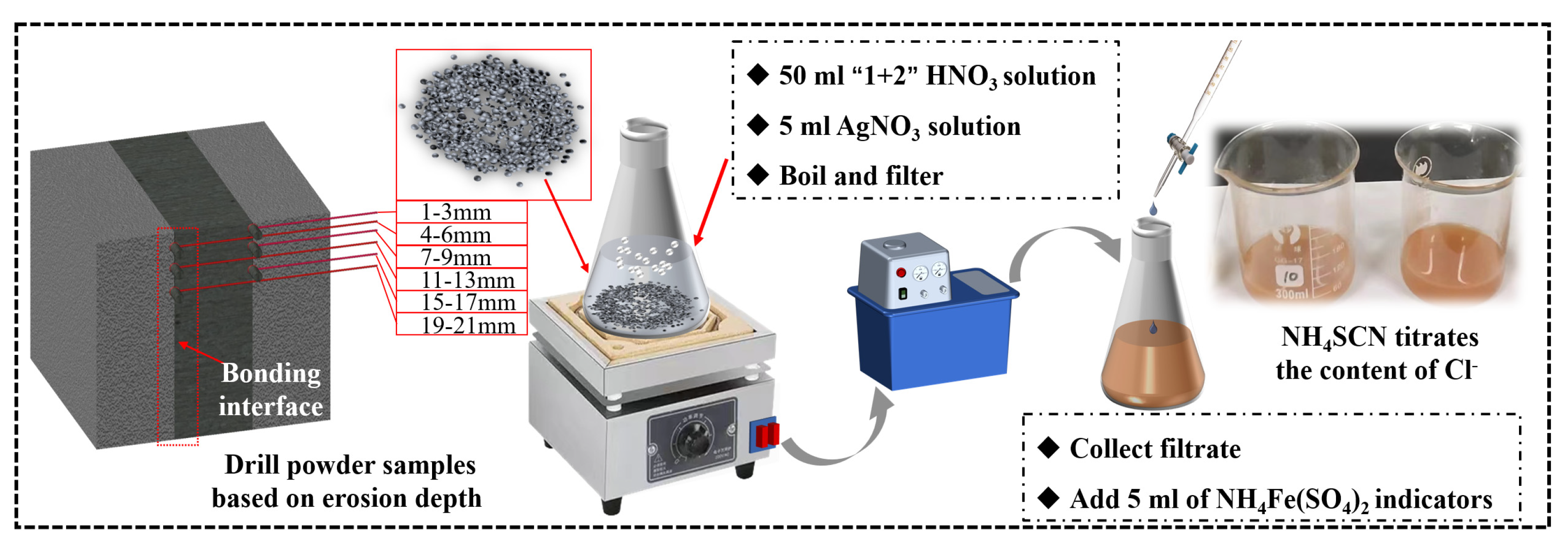
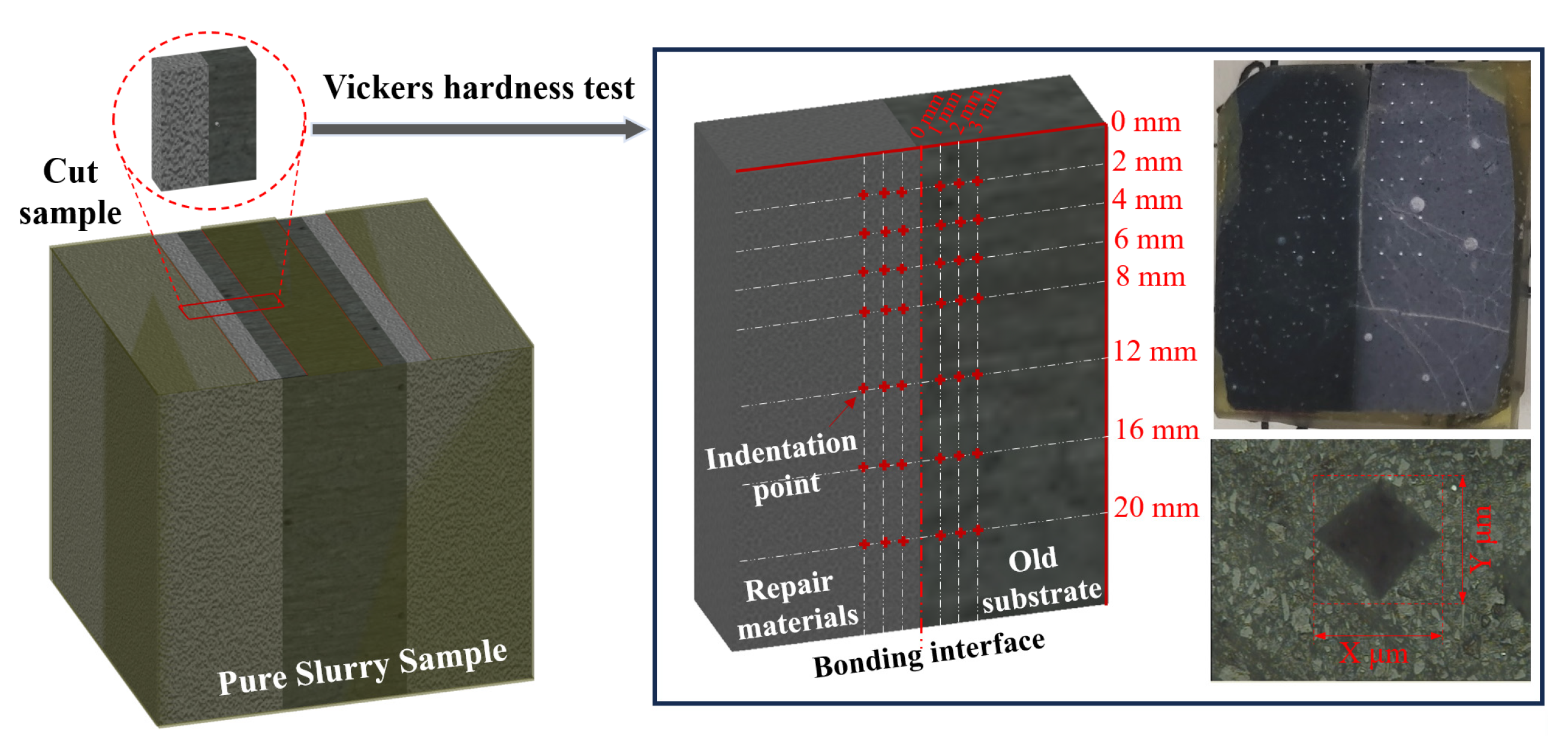

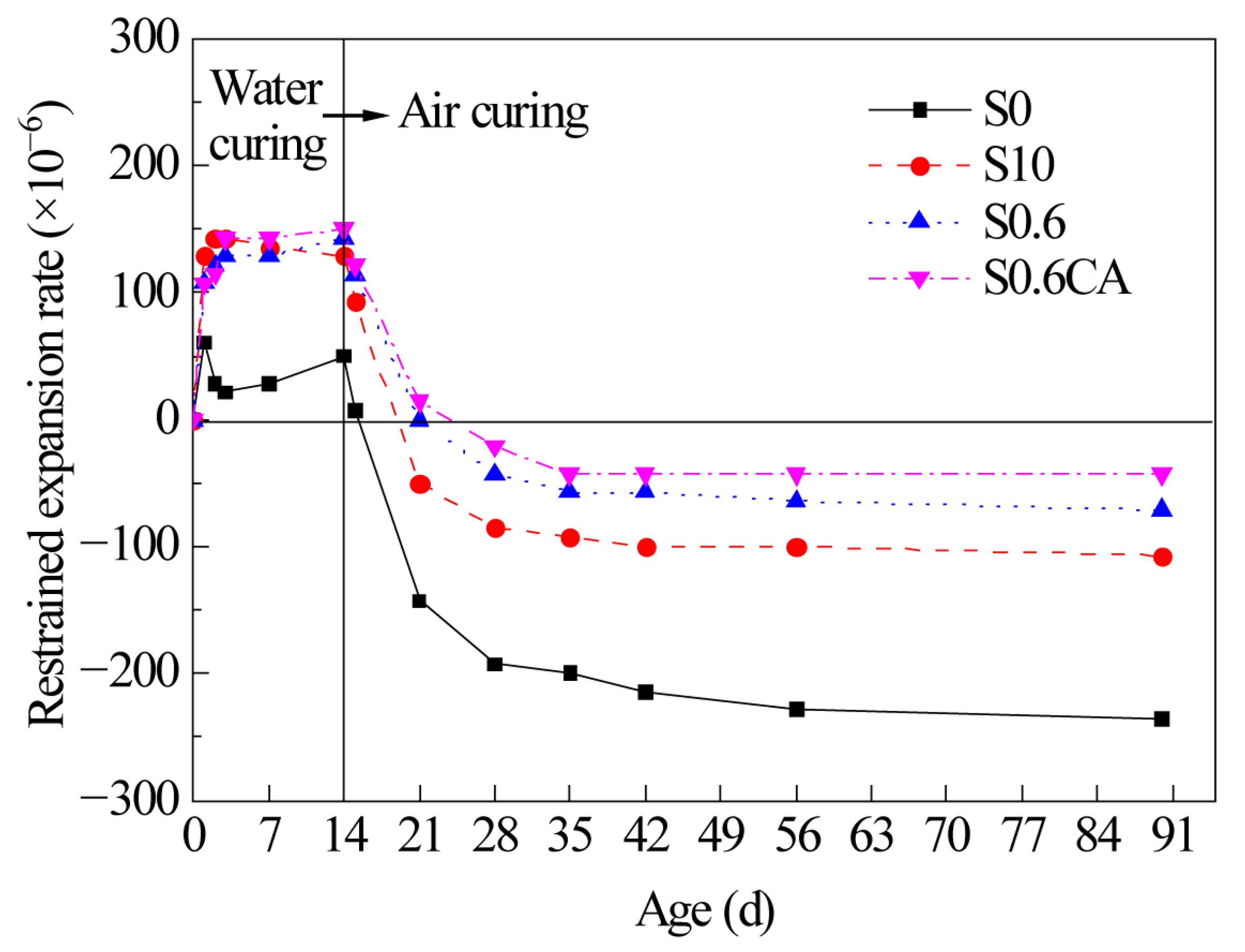

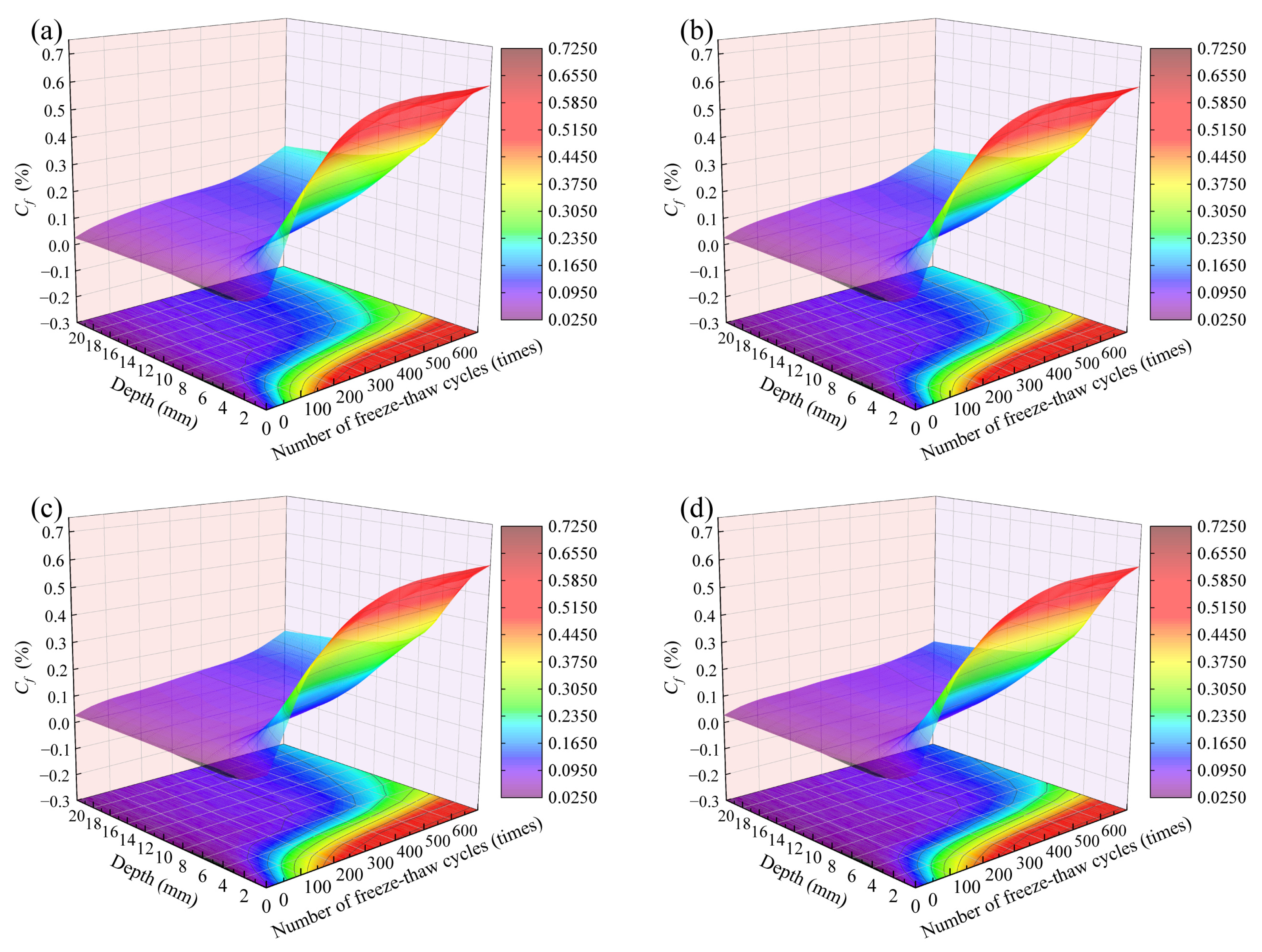

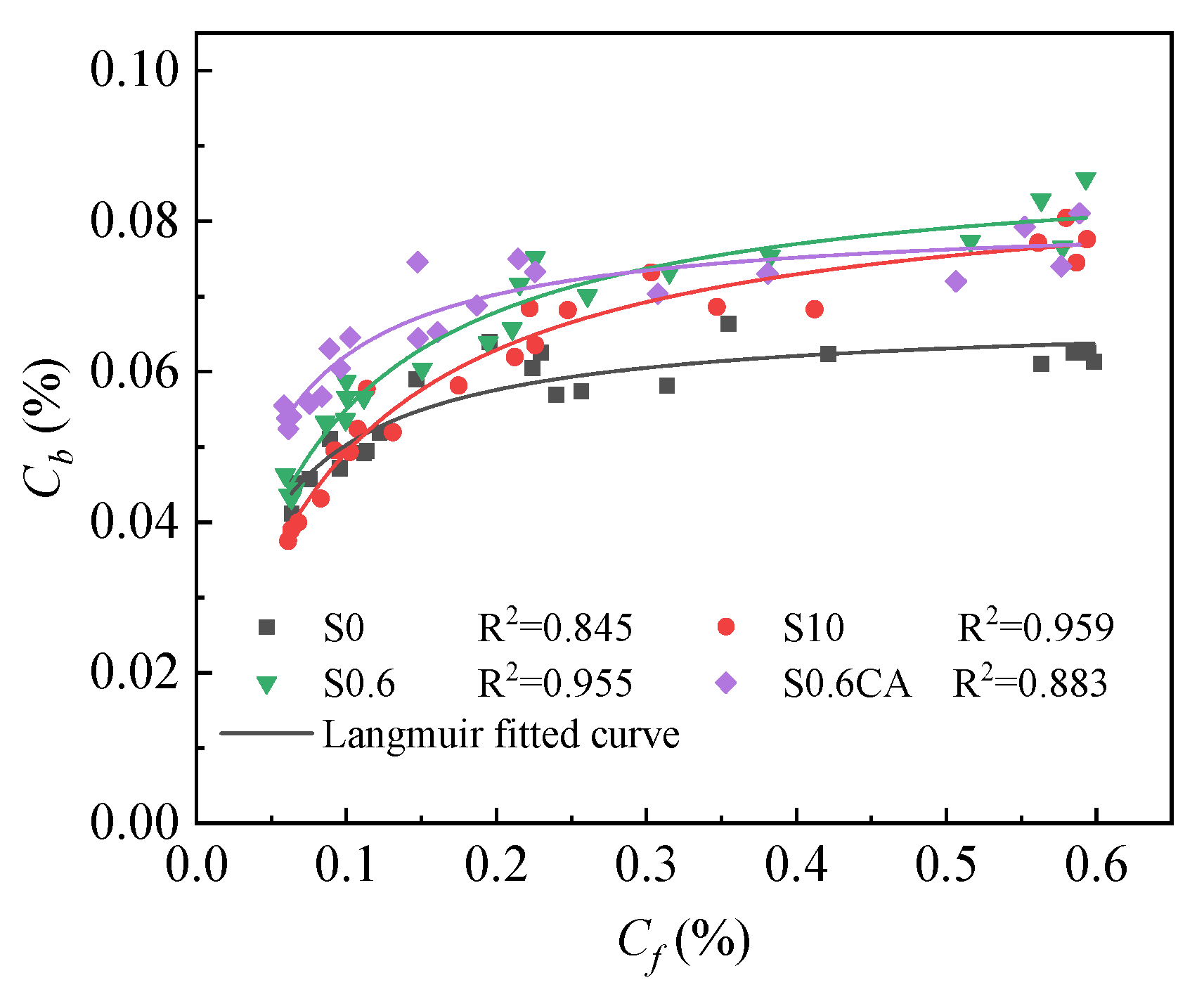
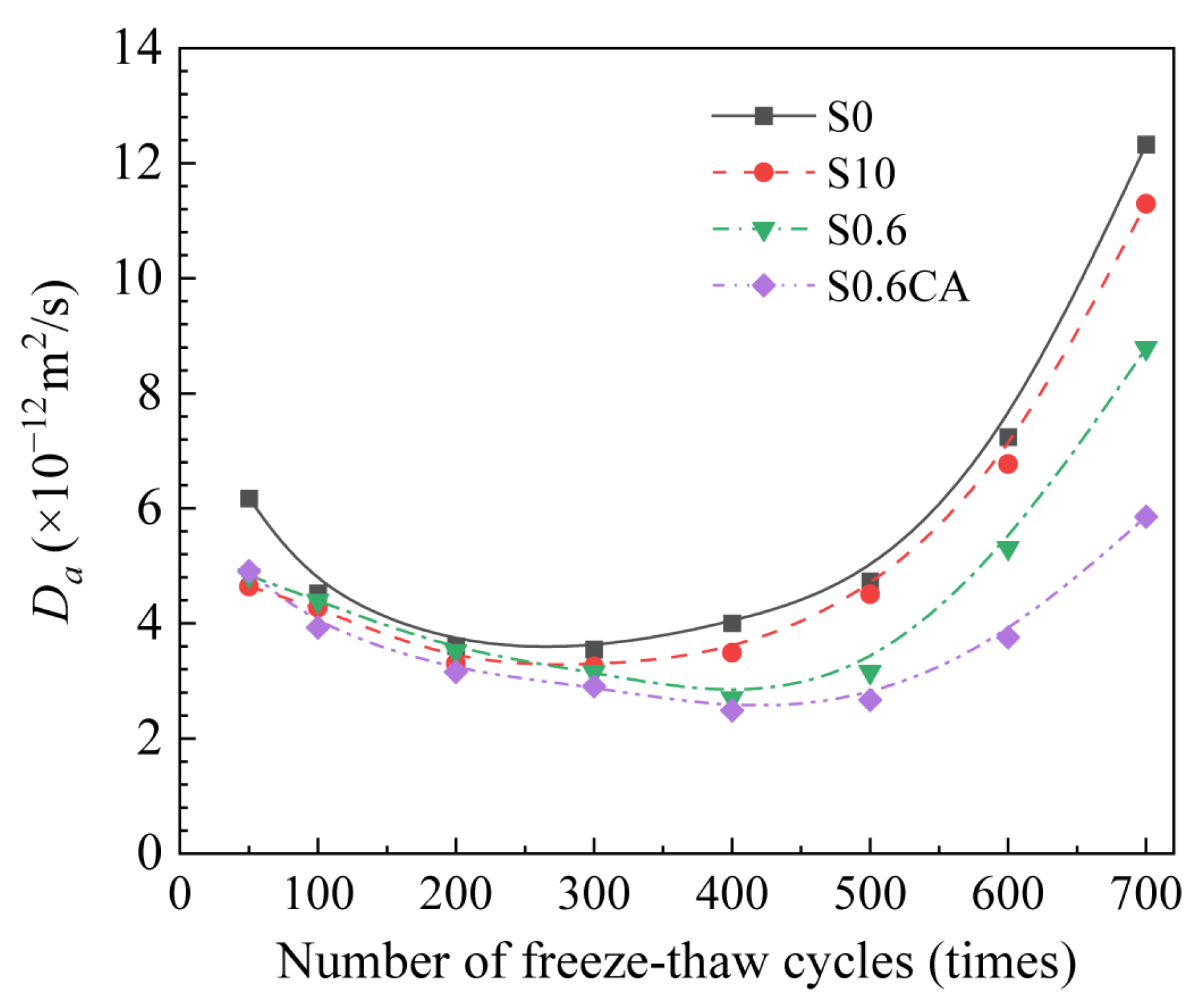

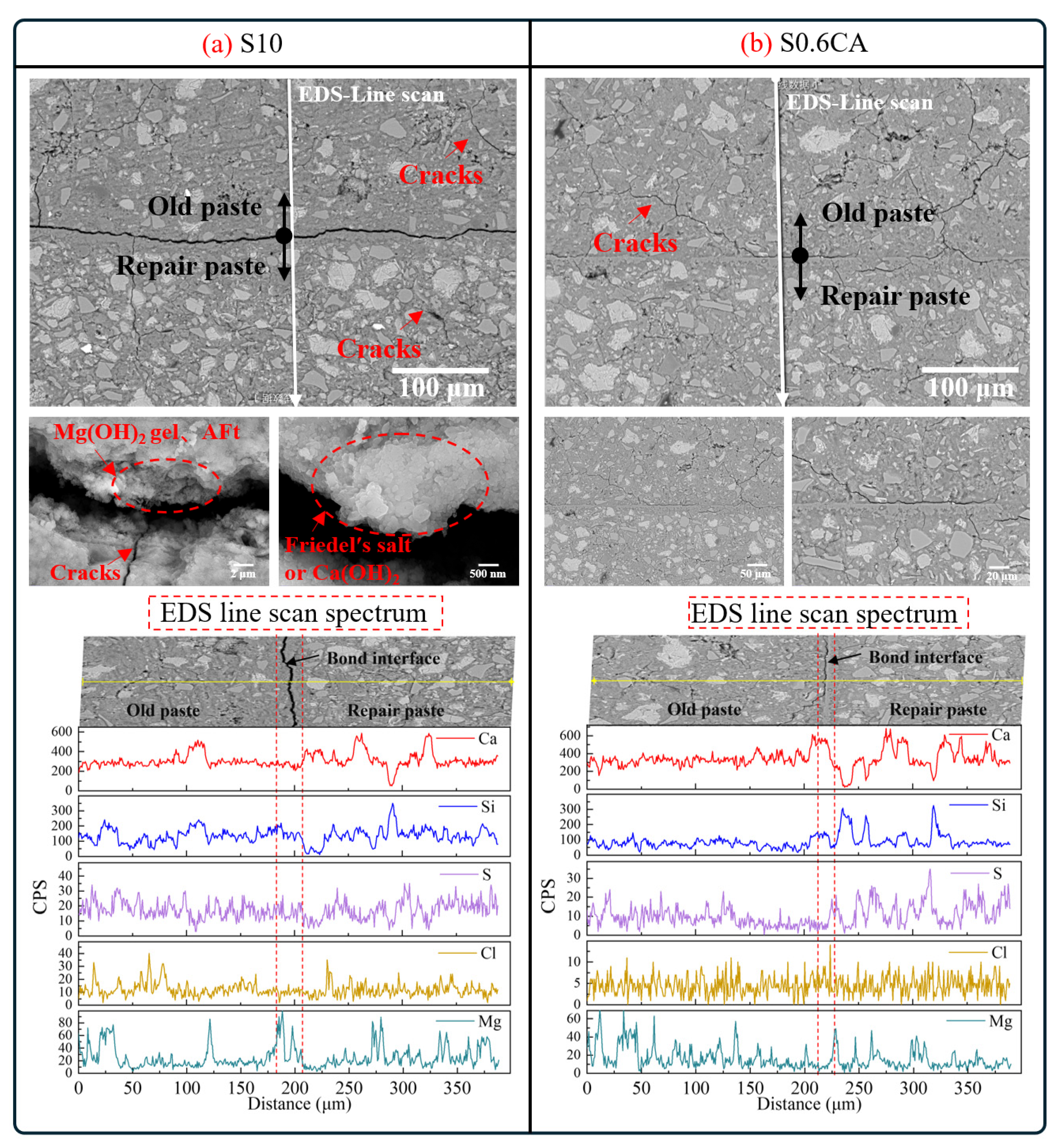
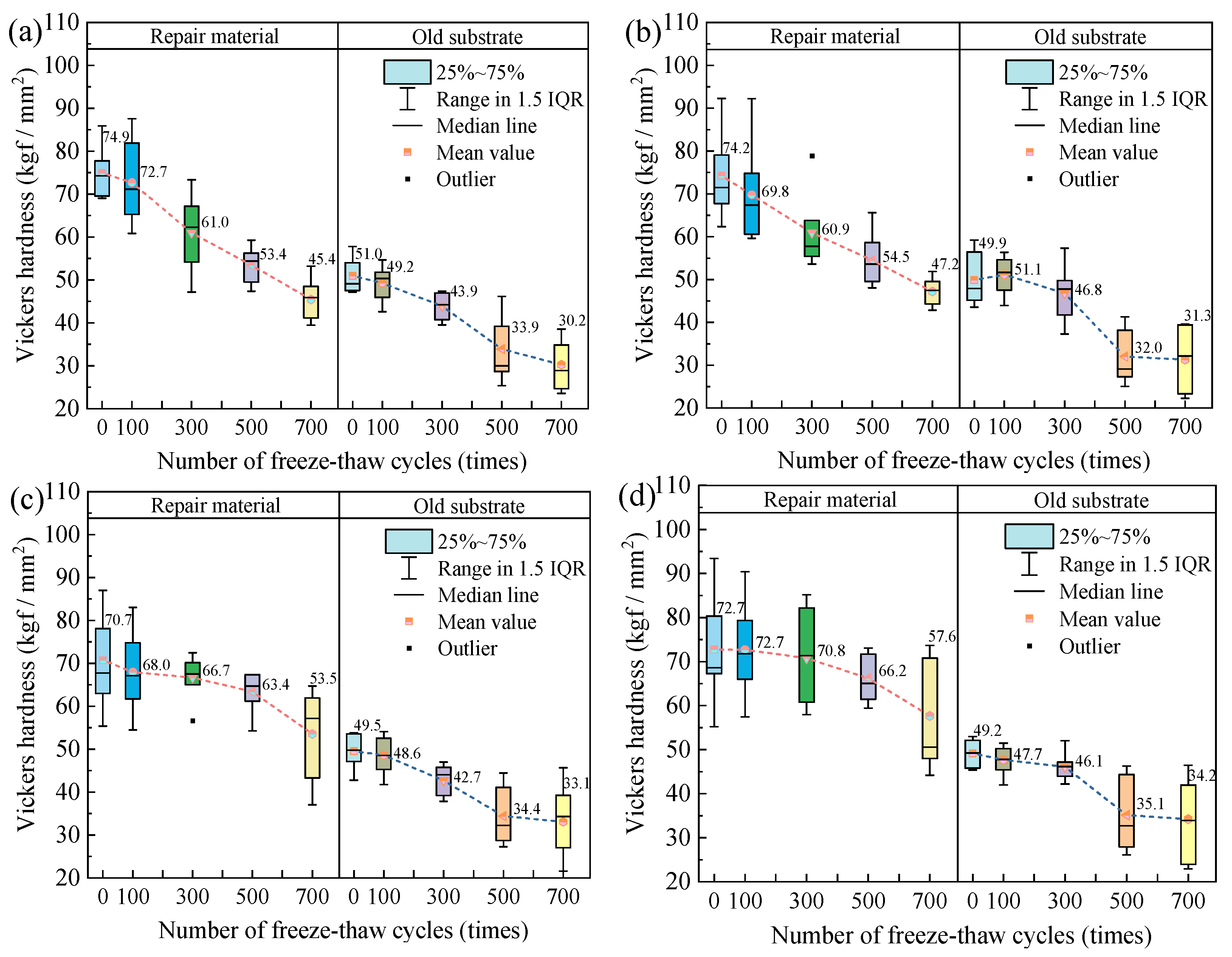
| CaO | Al2O3 | SiO2 | Fe2O3 | MgO | SO3 | K2O | Na2O | LOI | |
|---|---|---|---|---|---|---|---|---|---|
| OPC | 63.23 | 5.29 | 20.38 | 2.98 | 2.11 | 2.46 | 0.37 | 0.15 | 3.03 |
| SAC | 42.25 | 36.46 | 6.86 | 2.20 | 1.33 | 8.82 | 0.18 | 0.22 | 1.25 |
| GGBS | 40.81 | 18.46 | 31.55 | 2.42 | 4.13 | 2.05 | 0.24 | 0.13 | 0.21 |
| Specific Surface Area (m2/kg) | Setting Time (min) | Compressive Strength (MPa) | |||||
|---|---|---|---|---|---|---|---|
| Initial | Final | 1 d | 3 d | 7 d | 28 d | ||
| OPC | 362 | 168 | 213 | / | 36.2 | 40.3 | 55.7 |
| SAC | 350 | 30 | 65 | 30.5 | / | 45.0 | 47.9 |
| 42.5 OPC | FA | GGBS | S | PCE | W | |
|---|---|---|---|---|---|---|
| Cement paste substrate | 1020 | 320 | 160 | - | - | 560 |
| Mortar substrate | 462 | 132 | 66 | 1320 | 0.66 | 231 |
| Mix ID | OPC | GGBS | SAC | PVA | CAs | S | PCE | W |
|---|---|---|---|---|---|---|---|---|
| S0 | 738 | 316 | 0 | - | - | 1054 | 4.22 | 242 |
| S10 | 664 | 285 | 105 | - | - | 1054 | 4.22 | 242 |
| S0.6 | 664 | 285 | 105 | 8.16 | - | 1054 | 6.32 | 242 |
| S0.6CA | 664 | 285 | 105 | 8.16 | 10.54 | 1054 | 6.32 | 242 |
| NaCl | MgCl2·6H2O | Na2SO4 | CaCl2 | KCl | NaHCO3 |
|---|---|---|---|---|---|
| 24.53 | 11.12 | 4.09 | 1.17 | 0.69 | 0.20 |
| Fitting Parameters | S0 | S10 | S0.6 | S0.6CA |
|---|---|---|---|---|
| α1 | 1.705 | 2.272 | 1.584 | 1.750 |
| β1 | 25.967 | 24.106 | 13.971 | 14.193 |
| R2 | 0.845 | 0.959 | 0.955 | 0.883 |
Disclaimer/Publisher’s Note: The statements, opinions and data contained in all publications are solely those of the individual author(s) and contributor(s) and not of MDPI and/or the editor(s). MDPI and/or the editor(s) disclaim responsibility for any injury to people or property resulting from any ideas, methods, instructions or products referred to in the content. |
© 2025 by the authors. Licensee MDPI, Basel, Switzerland. This article is an open access article distributed under the terms and conditions of the Creative Commons Attribution (CC BY) license (https://creativecommons.org/licenses/by/4.0/).
Share and Cite
Niu, M.; He, X.; Wang, Y.; Shen, Y.; Zhang, W.; Li, G. Performance Degradation and Chloride Ion Migration Behavior of Repaired Bonding Interfaces inSeawater-Freeze-Thaw Environment. Buildings 2025, 15, 2431. https://doi.org/10.3390/buildings15142431
Niu M, He X, Wang Y, Shen Y, Zhang W, Li G. Performance Degradation and Chloride Ion Migration Behavior of Repaired Bonding Interfaces inSeawater-Freeze-Thaw Environment. Buildings. 2025; 15(14):2431. https://doi.org/10.3390/buildings15142431
Chicago/Turabian StyleNiu, Mengdie, Xiang He, Yaxin Wang, Yuxuan Shen, Wei Zhang, and Guoxin Li. 2025. "Performance Degradation and Chloride Ion Migration Behavior of Repaired Bonding Interfaces inSeawater-Freeze-Thaw Environment" Buildings 15, no. 14: 2431. https://doi.org/10.3390/buildings15142431
APA StyleNiu, M., He, X., Wang, Y., Shen, Y., Zhang, W., & Li, G. (2025). Performance Degradation and Chloride Ion Migration Behavior of Repaired Bonding Interfaces inSeawater-Freeze-Thaw Environment. Buildings, 15(14), 2431. https://doi.org/10.3390/buildings15142431





